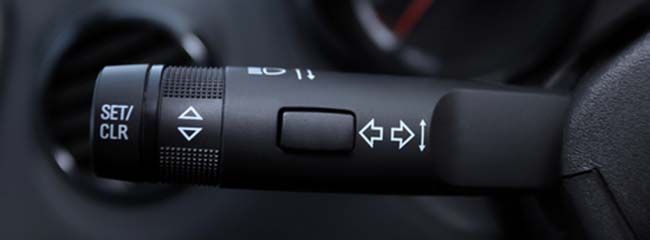The door-to-door salesperson is an extinct species, but in days of yore could be seen prowling the streets in nearly the same number as the bison who once roamed the prairie. Our parents and grandparents knew if one got a foot in the door, it could be trouble.
Valid grounds for making a stop is the police version of a foot in the door. Almost all DWI arrests start with a reasonable suspicion a minor traffic violation has occurred.
A common violation is failure to signal within 100 ft. of a turn —VTL § 1163(b). We all see it. We all do it (including many cops). Some people don’t signal until they start their turn, or are at or just near the intersection / driveway.
My client pulled into a right turn only lane, stopping at the red light. She signaled, waited for the light to change and was pulled over a few yards after her turn. The stop was based solely upon the failure to signal. It led to her arrest for DWI.
This happened around midnight during what I call “DWI Prime Time” (10 p.m. to 4:00 a.m.). The general rule during those hours is one can and will get stopped for any infraction.
I knew the corner. It was on Lake Avenue by City Court. My office is a few blocks away. The block was a short one. Armed with a tape measure, I went to the scene. The distance from the white line at the light to the beginning of the lane at the last side street was a few inches more than 96 ft. Since it was impossible to comply with the 100 ft. requirement, I challenged the stop.
The City Court Judge was a good sport and agreed to conduct part of the hearing on the street. I, along with the Assistant DA, the Judge, the police office, and my client went to the scene. I showed the Judge the shortness of the block, arguing it precluded a driver from obeying § 1163(b).
The statute’s intent is for drivers to notify others of their intended direction of travel. Being in a right turn only lane and signaling after she stopped at the red light fulfilled this intent, I argued. My client’s plan of travel was no mystery.
The Court upheld the stop, ruling she had a duty to signal as close as possible to the 100 ft. mark. Since she didn’t signal as soon as she pulled into the right turn lane 96 feet sooner, the officer had cause to stop her. The case was resolved with a non-criminal disposition lower than the DWI with a plea bargain. The signal ticket was dismissed, too. Had the Court ruled the stop invalid, all charges would have been dismissed.
The Judge remarked his decision was a close call. After the hearing, the officer was even teased by his sergeant for making a stop on such weak grounds. Weak, but still enough “reasonable suspicion” for a stop (I like the sergeant).
Any traffic violation is a “foot in the door” for the police. But unlike the traveling salesperson, the officer doesn’t need to convince you to buy anything.
No part of § 1163 prohibits signaling at distances exceeding 100 ft. You won’t get a ticket for signaling at 150 ft. If my client had, her stop would probably have been ruled invalid. Be aware signaling “too soon” can lead to confusion on the part of other drivers depending on what turns are in the area. Find the balance, but don’t wait past the 100 ft. mark. A foot and a whole lot more might come thru you door if you do.


Very interesting Kurt; food for thought...
ReplyThis serves as a cautionary reminder that even small, seemingly harmless opportunities can lead to unintended consequences if not approached carefully. paving indianapolis
Reply夢巴黎春藥網:https://pariss88.com/
女性催情春藥:https://pariss88.com/product-category/aphrodisiac/
女性迷幻春藥:https://pariss88.com/product-category/psychedelic/
印度正品代購:https://pariss88.com/product-category/medicine/
男性壯陽補腎:https://pariss88.com/product-category/kidney/
陰莖增大增粗:https://pariss88.com/product-category/thicken/
GB系列春藥:https://pariss88.com/product-category/aroused/
所有春藥商品:https://pariss88.com/shop/
春藥資訊:https://pariss88.com/blog/
關於我們:https://pariss88.com/about-us
Reply春藥對女性性慾望的顯著增強作用!
春藥是最受歡迎的女性催情藥物,讓愛火重燃的秘密武器!
春藥是什麼?揭開女性催情藥的神秘面紗
春藥如何影響女性性反應?揭開春藥的實際效果
春藥會讓人上癮嗎?揭開女性催情藥的真實效果與安全性
春藥效果解析:提升女性性慾與性愛滿意度的秘密武器
春藥對女性身體的深層影響:從血液循環到極致快感的全面解析
春藥的效果與作用:提升女性性慾望與性滿意度
春藥效果與作用全面解析:激發女性性慾與改善性冷淡
春藥是激發女性性慾望及提升性高潮快感的秘密武器
春藥的催情效果全解析:讓性愛更激情性高潮更猛烈
春藥效果大揭密:找回激情性愛的秘密武器!
女性服用春藥後的真實反應:從羞澀到淫蕩發騷的轉變
春藥如何幫助女性體驗激情性愛:全面指南
春藥:點燃女性激情,體驗極致性愛享受的秘訣
春藥如何通過刺激女性荷爾蒙來增強性快感?
春藥如何幫助女性找回激情性愛,享受極致快感?
春藥如何激發女性淫蕩慾望,讓女性主動求愛的?
春藥在兩性關係中起到哪些作用?解析春藥的效果
春藥在性愛中的關鍵作用:釋放女性淫蕩慾望
春藥如何讓女性淫蕩發情主動求歡:全面解析春藥效果
春藥如何幫助女性重燃性愛激情體驗美妙性高潮?
春藥的神奇效果:從淑女到淫蕩發騷的轉變
春藥的催情效果:讓女性在性愛中欲仙欲死的極致體驗
春藥的效果:激發女性性慾望的深度解析
春藥番外篇:天然春藥與合成春藥的效果對比
Reply春藥
媚藥
催情春藥
催情藥
女性春藥
春藥哪裡買
春藥推薦
春藥是什麼
春藥水
有效春藥
正品春藥
無色無味的春藥
網購春藥
進口春藥
女性媚藥
日本媚藥
日本春藥
春藥真的有用嗎
春藥有副作用嗎
催淫春藥
春藥膠囊
粉狀春藥
液體春藥
昏睡春藥
迷情春藥
迷幻春藥
催眠春藥
口交水
聽話水
乖乖水
失憶水
催情水
迷姦水
迷姦藥
迷幻藥
高潮液
催情液
春藥粉
女性發騷水
淫蕩發騷春藥
女性催淫春藥
激發女性性慾
增強性快感
增加女性主動
增加女性分泌物
增加女性敏感度
治療女性性冷淡
誘發女性性渴望
事後無記憶
迷幻催情春藥
昏睡失憶春藥
強效催情春藥
女性淫蕩發騷
女性催情膠囊
無副作用春藥
女性潮吹春藥
男女通用型春藥
催情口服液
無色無味的春藥
催情春藥水
女性催情媚藥
昏睡迷姦春藥
無色無味春藥水
超強淫蕩媚藥
女性外用春藥
刺激陰蒂快感
女性催情高潮液
女性私處高潮液
女性高潮潤滑劑
女用催淫凝膠
強效催情凝膠
發騷春藥凝膠
Reply